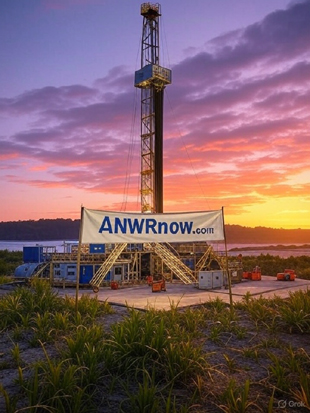

Hot-Button Topic: ANWR, a 19 million acre Alaskan refuge, is ground zero for U.S. energy vs. conservation battles. Owning ANWRnow.com positions you at the intersection of a high-stakes environmental and energy debate, with timely relevance in 2025 amid renewed pushes for Arctic oil leasing. It's a concise .com (7 characters) tied to "ANWR" (Arctic National Wildlife Refuge), a term with deep political and economic resonance. No major trademarks or legal conflicts appear in searches, and it's a blank slate with minimal history, reducing risks.
In essence, ANWRnow.com is a high-potential domain for influencers, orgs, or investors betting on America's energy future by leveraging a decades-old controversy that's peaking now. With low overhead and narrative control, it's more than a URL; it's a stake in the debate. If your angle is pro-drilling or conservation, reach out to the Nick below ASAP. What's your vision for it? Advocacy site or investment flip?

National Security: Reducing dependence on foreign oil enhances energy security, particularly in a volatile global market where geopolitical tensions (e.g., Middle East conflicts or sanctions on oil-producing nations) can disrupt supply chains. ANWR's resources could provide a reliable domestic source, strengthening U.S. energy independence.
Minimal Environmental Footprint: Modern drilling technologies, such as directional drilling and smaller well pads, minimize surface disturbance. The 1002 Area, targeted for drilling, spans 1.5 million acres, but only about 2,000 acres (0.01% of ANWR's total 19 million acres) would be directly impacted, according to industry estimates. Proponents argue this limited footprint, combined with strict environmental regulations, mitigates harm to wildlife like caribou or polar bears, especially since the Coastal Plain is not a pristine wilderness but a tundra region already used for some industrial activity.
Alaska Native Support: Some Alaska Native communities, such as the Inupiat in Kaktovik, support drilling due to potential revenue and infrastructure development. Royalties and taxes from oil production could fund schools, healthcare, and other services in remote regions, as seen with existing North Slope oil operations.
Countering Opposition: Critics highlight environmental risks, but proponents argue that decades of successful oil operations in nearby Prudhoe Bay demonstrate that industry can coexist with Arctic ecosystems. Advances in spill prevention and response further reduce risks. Additionally, the revenue from drilling could fund renewable energy research, aiding the transition to a lower-carbon future.
In summary, drilling in ANWR could yield substantial economic, security, and local benefits while leveraging modern technology to minimize environmental impact, making it a pragmatic step for U.S. energy policy.
Environmental Risks: Despite claims of a small footprint (2,000 acres), the infrastructure required-roads, pipelines, and gravel mines-would fragment the ecosystem, potentially affecting far more than the direct drilling area. A 2017 study by the National Audubon Society highlighted risks of oil spills, which are difficult to clean in Arctic conditions. The Exxon Valdez spill (1989) demonstrated long-lasting ecological damage in Alaska, and ANWR's remote location complicates response efforts.
Climate Change Concerns: Extracting ANWR's estimated 4.3-11.8 billion barrels of oil (USGS, 1998) would contribute to greenhouse gas emissions, exacerbating global warming. The Arctic is warming at four times the global rate (NOAA, 2024), amplifying permafrost thaw and habitat loss. Drilling conflicts with U.S. climate goals, such as reducing emissions by 50% by 2030, as burning ANWR oil could release billions of tons of CO2, per EPA carbon intensity estimates.
Cultural and Indigenous Impacts: While some Inupiat support drilling, the Gwich'in Nation, whose communities rely on the Porcupine caribou for cultural and subsistence purposes, strongly opposes it. A 2019 Gwich'in Steering Committee report emphasized that disrupting caribou herds threatens their way of life, outweighing potential economic benefits for others.
Limited Economic Impact: The economic benefits of drilling are overstated. The Energy Information Administration (2023) projects that ANWR production would contribute less than 2% of U.S. oil demand by 2040, with minimal impact on global oil prices. Job estimates (e.g., 130,000 jobs) are speculative and include indirect effects, while Alaska's oil industry has declined due to market shifts toward renewables.
Alternatives Exist: Investing in renewable energy and energy efficiency offers greater long-term economic and environmental benefits. The U.S. added 32 gigawatts of renewable capacity in 2024 alone (DOE), creating jobs and reducing reliance on fossil fuels without sacrificing pristine ecosystems.
In summary, drilling in ANWR risks irreversible ecological and cultural damage for marginal economic gains, undermining climate goals and viable renewable alternatives. Protecting this unique wilderness preserves biodiversity and respects Indigenous rights while aligning with a sustainable energy future.
|
Nick Rush, General Manager Rockfish Valley Purveyor, LLC. rvpurveyor.com digitalwomb@gmail.com |

|